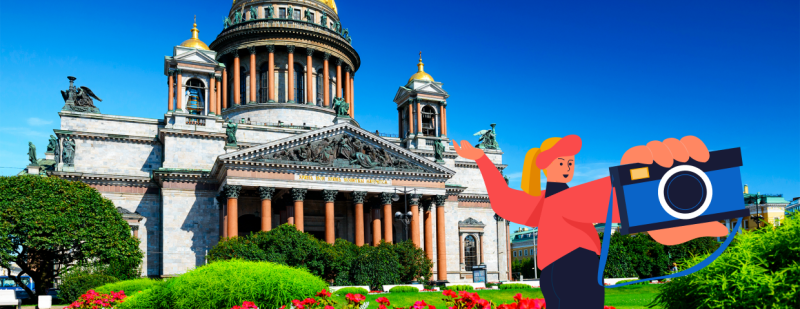
We tell you what treasures UNESCO protects in Samarkand and what you definitely need to see, visit and try, so that later, in conversation with friends, you can enthusiastically say: “Oh, wonderful East!”
Content
- How to get there
- Where to stay
- What to see
- What to buy
- Where to try pilaf
- Tips
Uzbekistan: the main thing
- Currency: Uzbek sum. At the time of writing, 1 RUB = 142.8 UZS. Russian cards do not work in the country.
- Time difference from Moscow: -2 hours.
- Visa: Russians do not need to travel for up to 90 days.
- When is the best time to go: in spring or autumn, in April-May or September-October.
How to get there
Is easy and simple: direct flight from Moscow to Samarkand, travel time is 4 hours, ticket prices start from 5,600 rubles one way. You can also get from St. Petersburg, Novosibirsk, Yekaterinburg and other major cities without transfers and, importantly, for more or less reasonable money (hello, Istanbul!).
Another working option is to fly to Tashkent (the cost of a ticket from Moscow starts from 5,200 rubles), and from there get to Samarkand by train in two hours (the cost starts from 2,100 rubles).
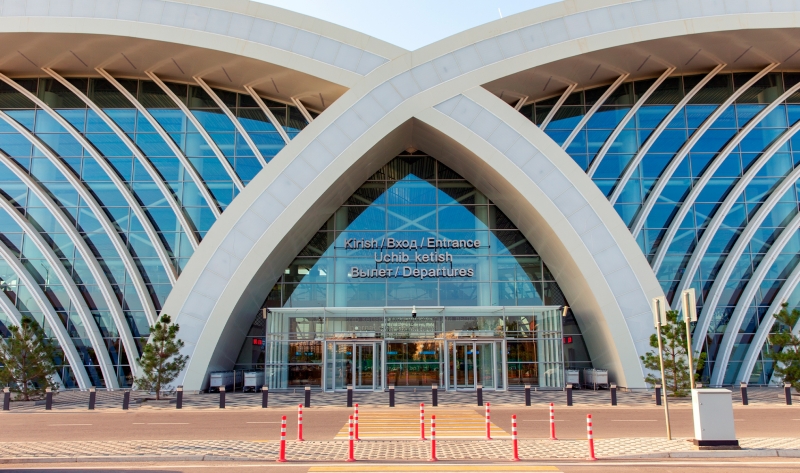
You can take a direct flight from Moscow to Samarkand, the journey time is 4 hours. Photo: ArtEvent ET/Shutterstock.com
Where to stay
Kosh Havuz Boutique Hotel
Silk Road Empire Hotel
Ideal for those who want to immerse themselves in the culture of the East: staying at the hotel will already become a kind of journey through the world of carpets, national patterns and other details that make up Uzbekistan.
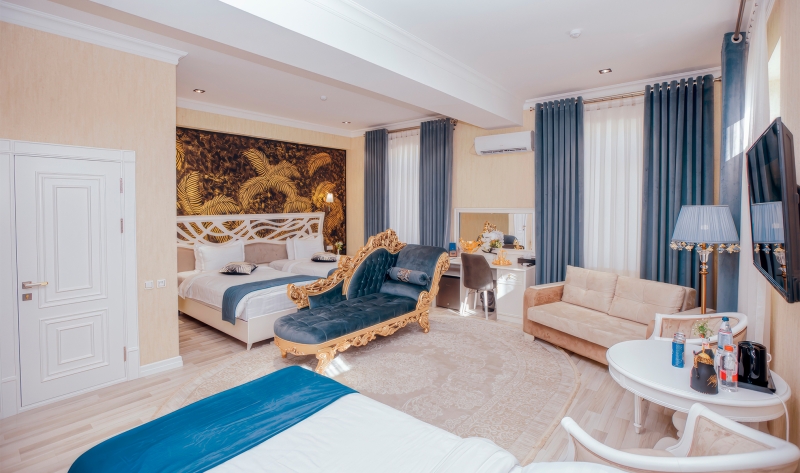
Silk Road Empire Hotel.
Gur Emir Palace
Ko’k Saroy Plaza
Brand new hotel is a five-minute walk from Registan Square. It is convenient for lovers of long walks who prefer to start the day with breakfast at the hotel.
Siab
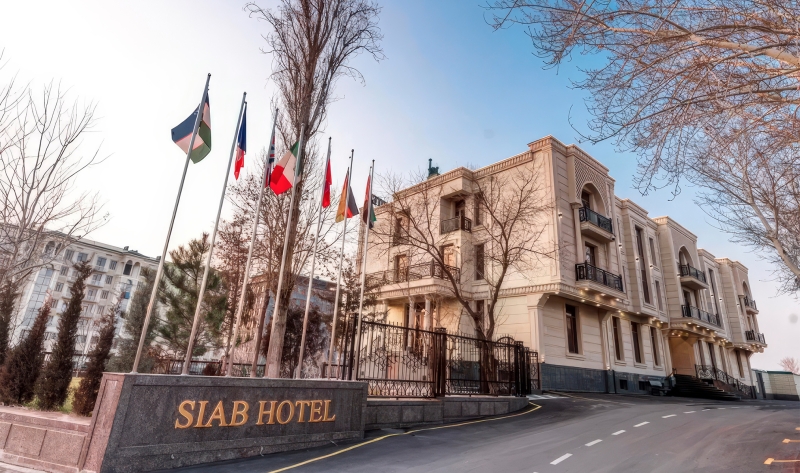
Siab.
Historical background
The city was founded back in the 8th century BC. Over the past millennia, it has managed to visit the capital of the empire of the conqueror Tamerlane, a medieval scientific center, part of the Russian Empire and the capital of the Uzbek SSR in the Soviet Union. Therefore, you can wander here and marvel at the neighborhood of magnificent minarets and merchant mansions with Khrushchev towers. And the portals to the past are the vaults of mosques, reminiscent of stalactites, mosaics and the aroma of spices in the bazaar.
What to see
Registan Square
The architectural appearance of Registan was formed in the XIV–XVI centuries, and the beginning of landscaping is attributed to Tamerlane, who took care of decorating the capital of his empire. Today, more than 6 million tourists come to appreciate his efforts every year, and the square itself is included in the UNESCO World Heritage List. In the Middle Ages, it was something like a university campus. There are three majestic madrasahs located here — Ulugbek, Sherdor and Tillya-Kori.
You can look at them for hours: blue-blue tiles, mosaics, marble carvings, gilding, ornaments and floral patterns — the craftsmanship is fascinating. I’m tempted to take up the camera again and again in an attempt to capture the beauty!
Ulugbek Madrasah is famous for the symbolic image of the starry sky on the facade. Sherdor is interesting for the lions above the main arch, and Tillya-Kori is called golden for the precious metal used in the decoration. There are small historical exhibitions inside, as well as souvenir shops with traditional ceramics and handicrafts.
The entrance ticket to Registan Square costs about 275 rubles. In the evening, the madrasahs are illuminated, and sometimes they arrange a laser show.

You can look at them for hours: blue-blue tiles, mosaics, marble carvings, gilding, ornaments and floral patterns — the craftsmanship is fascinating. Photo: Sergey Dzyuba/Shutterstock.com
Gur-Emir Mausoleum
The monumental mausoleum with the ashes of the great commander Tamerlane was built in the XV century. The majolica-covered dome is made in the traditional azure color, and the interiors are decorated with gold. In the post-Soviet cultural space, there are legends about Tamerlane’s grave with a mention of a curse: as if the spirit of war is imprisoned in it. Do not be afraid to disturb him: there is nothing under the stone tombstones, the ashes of the ruler of the world rest in the depths of the crypt.
The entrance ticket to the mausoleum is about 170 rubles. Local guides offer their services near the entrance. To get an impression not only of the mausoleum, but also of the history of the city as a whole, we recommend that you sign up for a sightseeing tour. There are many of them, for example, on Tripster:
Bibi Khanim Mosque
If you think that there was no romance in Tamerlane’s time,Go to the Bibi Khanim Cathedral Mosque. Many legends are connected with its construction: according to one of them, Tamerlane’s beloved wife began to build the mosque in order to please her husband, who disappeared in another military campaign. According to another story, the building was built by the will of an invincible (almost) commander and named after his beloved wife: literally translated, the name means “eldest princess.” However, the testimony of historians about who this beloved wife was varies slightly, and there is also a legend about a talented architect who dared to fall in love with the ruler’s wife.
Anyway, the mosque is magnificent. Poets of olden times compared domes to the firmament, and the mosaic arch of the portal to the Milky Way. It is one of the largest mosques in Central Asia: 10,000 worshippers can pray in it at the same time.
In the courtyard of the mosque there is a lavkh, a huge stone stand for the holy Quran. They say that if you make a wish and bypass it three times, your plan will come true.
The ticket price is 275 rubles.
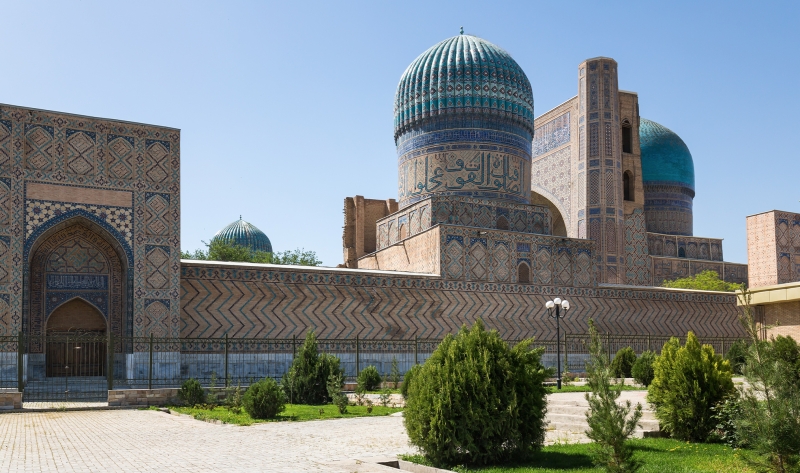
Anyway, the mosque is magnificent. Photo: Pavel Guskov/Shutterstock.com
Museums of the history of Samarkand
For accurate information and artifacts of past centuries, go to Afrasiab. Here you will find swords and arrows from the time of Alexander the Great’s campaigns, a palace fresco from the 7th century, ceramics and coins.
The museum is located next to the ancient settlement of the same name, destroyed during the Mongol invasion. You can get to its territory for free, and the cost of a ticket to the museum is about 170 rubles. Another important point is the Samarkand Regional Museum of Local Lore, which is also a former palace built by local merchant Abram Kalantarov for Emperor Nicholas II in 1916. The autocrat did not come to visit, but soon the Bolsheviks appeared on the doorstep, and the enterprising merchant exchanged a luxurious house for his life. Alas, at the time of writing, the museum is temporarily closed, we are waiting for the opening.

For accurate information and artifacts from past centuries, go to Afrasiab. Photo: Alexandre.ROSA/Shutterstock.com
Islam Karimov Street
Shahi Zinda Necropolis
To visit the complex, you need to buy a ticket worth 170 rubles.
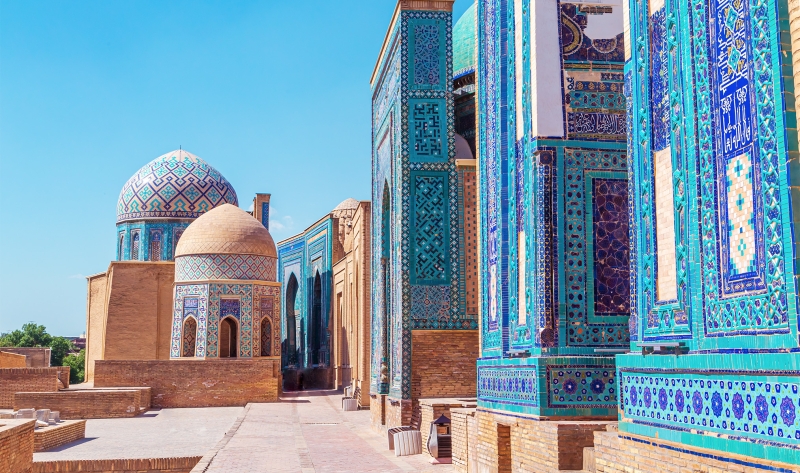
All buildings are made in the same style: square with a domed roof, decorated with blue and blue majolica and patterns. Photo: Lizavetta/Shutterstock.com
What to buy
The classic “I came, I saw, I bought” does not work in oriental bazaars. Here, any purchase, from a handful of nuts to the stunning beauty of a ceramic dish, is a long and fascinating process. This happened centuries ago, when the Silk Road passed through Samarkand, with its abundance of goods and merchants. The tradition persists to this day: accept it, take note and have fun.
The Siab Bazaar next to the Bibi Khanim Mosque is a real test for the purse, luggage and shelf space in any tourist’s apartment. As it was several centuries ago, you can find handicrafts, ceramics and textiles here, as well as spices, nuts, tea, oriental sweets, including Samarkand halva. By the way, the main gates of the bazaar are also a work of art, don’t forget to look at them.
We also recommend Chorsu bazaar to inveterate shopaholics: just remember that there is no way to fit all the coveted ceramics into a standard apartment.
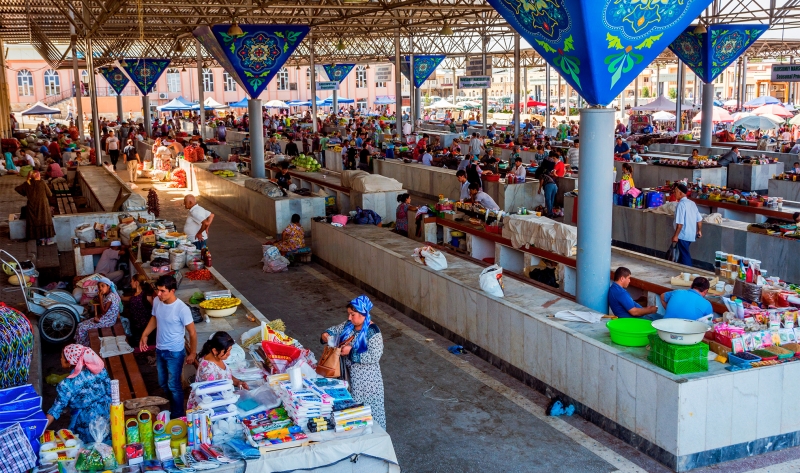
The Siab Bazaar next to the Bibi Khanim Mosque is a real test for the wallet, luggage and shelf space in any tourist’s apartment. Photo: Ana Flasker/Shutterstock.com
Where to try pilaf
Being in Samarkand and not trying the local pilaf is a crime against the passport, stomach and Alexander the Great, from which the dish almost made a gastroblogger. According to legend, Samarkand pilaf was first prepared for the commander. According to another version, Macedonsky himself was the author of the recipe. Look for the right option with chickpeas, yellow carrots and raisins in the “Pilaf Center No. 1” or “Pilaf Center”.
Not a single pilaf
We tell you in detail about the gastronomic delights of Uzbekistan, including Samarkand pilaf and samsa, in our delicious guide. We strongly advise against reading on an empty stomach.
Tips
- The dress code should be observed when visiting Muslim shrines. Open hair and short skirts are unacceptable for women.
- Haggling in the bazaar is possible and necessary.
- Remember that you need to eat pilaf before one o’clock in the afternoon, it will be difficult to find it later.
- Before photographing the locals, it is better to ask for permission.
Samarkand conquers hearts and remains in memory with the azure and brilliance of minarets, the noise of bazaars, romantic love stories and, of course, delicious pilaf.
Advertisement. Hotel Booking LLC. Erid: 2Vtzqw8YUNs
Cover photo: Pikoso.kz /Shutterstock.com
